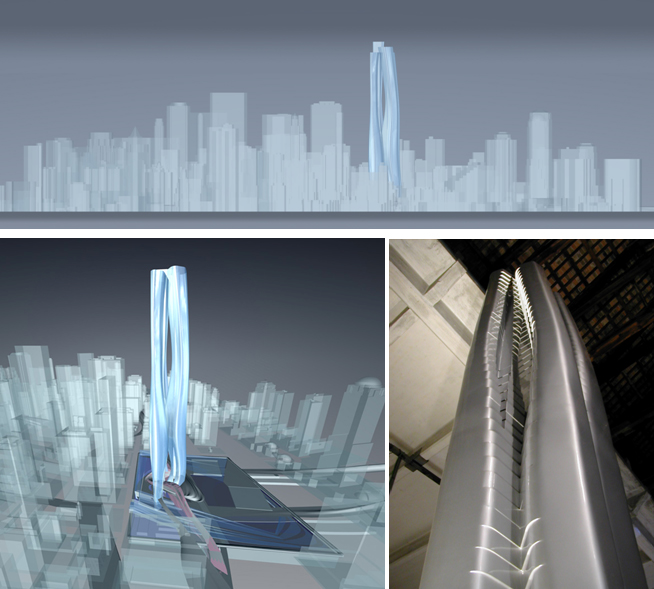
Minoru Yamasaki, New York World Trade Centre – the ultimate symbol of the era of fordist mass production
What’s next? From Destructive Impact to Creative Impulse
Patrik Schumacher, London 2002
Published in: New Architecture – Essays on Architecture, Editor: Sheila de Vallee,
Papadakis Publisher, New Architecture Group Ltd., London 2007
The tragic destruction of the World Trade Center raises the question of what could replace it. Rather than calling for a symbolic response the question is what kind of organizational structure would satisfy contemporary business life and what kind of formal language would articulate it? What is the functionality and aesthetics of the contemporary metropolis? How – if at all – should it’s essence appear on the Manhattan Skyline?
New York’s World Trade Center was one of the largest and most ambitious structures ever built.
This complex - comprising the twin towers plus 5 lower buildings - was designed by Minoru Yamasaki in mid-to-late sixties. This was at the peak of the era of Fordism - the system of assembly-line mass production that led to modern mass society organised around huge corporations. The world Trade Center was one of the culminating investments of the long post war boom. Construction of the towers started in 1969 and was completed in 1973. The Twin Towers alone offered 1 million square meter of office space spread over 110-stories. The total centre offered working space for 50,000 people. This is equivalent to the population of a medium sized city.
Fordism in general was marked by massive endeavours. Everything was produced in bulk quantities and everything was based on standardization and reproduction. Grids, series, and the repetition of the same! The serial aesthetic of Mies van der Rohe’s American period was the most pertinent expression of Fordism in architecture. Yamasaki’s twin towers developed this principle to its ultimate symbolic conclusion: Even such an enormous, iconic structure like the great American skyscraper could be subordinated to the principle of repetition.
The repetition of the same operates between the two towers as well as within each tower.

Minoru Yamasaki, New York World Trade Centre – the ultimate symbol of the era of fordist mass production
The epoch of the skyscraper is over - not primarily because of concerns for security - but because the sky-scraper’s organizational structure is too simple and too constricting. Towers only grow in one dimension. The strict linearity of its extension accounts for its characteristic poverty of connectivity. Towers are hermetic units, which are themselves arrays of equally hermetic units (floors). These features of linearity and strict segmentation are anti-thetical to contemporary business relations as well as to contemporary urban life in general. Much higher levels of complexity are required to spatially order and articulate contemporary relations.
Architecture as Urbanism
The demise of fordism and of the skyscraper as its urban archetype does not imply the retreat from the large scale nor from high density. Both bigness and density are increasing within the contemporary metropolis.
The exhaustion of the historic city centers - there are simply not enough of them to satisfy the insatiable need for contemporary urbanity - and the bankruptcy of comprehensive city planning in the face of market uncertainty, means that architecture has to carry the burden of urbanism within large single developments. Architecture has been mostly overburdened with this task. However new spatial models should be able to organize higher levels of complexity and integrate significantly more simultaneous programmatic agendas and divers life-processes.
But how can appropriate spatial patterns be invented and how can the required spatial complexity be build up?
The task is to devise strategies that could produce large buildings that fulfill the function of urban communication and exchange.
We will project an entity of a higher order than what one usually considers as "building" or even "ensemble", an entity that recreates within itself approximations of the multiplicity, complexity and effectiveness of the urban: a city compressed into a large building.
Also: The time factor is to be introduced in scenrios of phasing and re-configuration. We believe that the large components of the contemporary metropolis have to be conceived as evolving rather than finished and fixed structures.
We should tackle this significant site only after we have gathered sufficient intellectual and creative resources, i.e. after we are satisfied that our intervention has a chance to articulate the essential operations and ambitions of the contemporary metropolis with the same poignancy and profundity that made the world trade centre such an effective symbol of modern civilisation.
Approaching the task in this spirit opens up the opportunity to realise a large scale urban intervention with a significant transformative impulse for the whole of Manhattan.

Zaha Hadid Architects – Sketch for new World Trade Centre, 2002 – Bundle Tower, emphasising interface with gound networks as well as vertical navigation space.